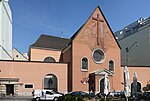Kärntner Straße
Austria stubsInnere StadtPedestrian streets in AustriaShopping districts and streets in AustriaStreets in Vienna

Kärntner Straße (Carinthian Street) is the most famous street in central Vienna. It runs from the Stephansplatz out to the Wiener Staatsoper at Karlsplatz on the Ringstraße. The first record of Kärntner Straße is from 1257, as Strata Carintianorum, which refers to its importance as a trade route to the southern province of Carinthia.
Excerpt from the Wikipedia article Kärntner Straße (License: CC BY-SA 3.0, Authors, Images).Kärntner Straße
Donnergasse, Vienna Innere Stadt
Geographical coordinates (GPS) Address Nearby Places Show on map
Geographical coordinates (GPS)
| Latitude | Longitude |
|---|---|
| N 48.206 ° | E 16.371 ° |
Address
Donnergasse
Donnergasse
1010 Vienna, Innere Stadt
Austria
Open on Google Maps










